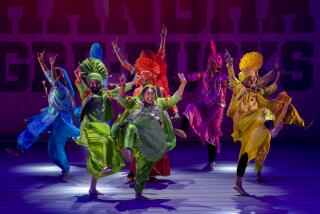‘Mahabharata’--in Condensed Form
- Share via
Simply put, “The Mahabharata,” one of India’s two major Sanskrit epics, is staggering.
At about 100,000 stanzas, it is 15 times longer than the Bible and eight times as long the “Iliad” and the “Odyssey” combined.
Its cast of characters--gods, demigods, demons and humans--is immense.
It is full of wondrous and horrific stories, all directed toward examining the concept of dharma, or appropriate codes of conduct.
Unlike “The Ramayana,” the other great Sanskrit epic, which is basically a love story, “The Mahabharata” is about war.
The work explores the exorable but often obscure web of cause and effect (karma) and scrutinizes the complexity of making moral choices. Such choices rarely turn out to be easy.
Among the work’s many chapters is one of the most significant religious texts ever conceived--the “Bhagavad Gita” (The Song of the Lord), a discourse on reality and illusion, the discipline required to discern between the two and the indestructibility of the soul.
Peter Brook, the British director who staged a “Mahabharata” broadcast by PBS in 1989, said it would take more than a year to narrate the whole story.
A new version will be danced Sunday at the Irvine Barclay Theatre by the Bharata Kalanjali troupe from Madras, India. Fortunately, it won’t take them a year to do it.
The program, consisting of nine key scenes, with the gaps filled in by a narrator, will open with the traditional homage to Ganesha, the elephant-headed god, son of Shiva and Parvati and remover of obstacles, who agreed to take down the immense poem at the dictation of its creator, Vyasa.
The program will end, about 2 1/2 hours later, with the coronation of the Pandavas, the heroes of the story.
“It’s a gala ending,” said company artistic director V.P. Dhananjayan, speaking from Indianapolis, where a current 25-city U.S. tour began Sept. 18. (The tour ends in New York on Oct. 21.)
“Mahabharata”--which is accented on the third syllable, not the fourth--means “Great Epic of the Bharata Dynasty.” By extension, it can be translated as “The Great History of the Human Race.”
The basic story concerns the struggle between two sides of a single ruling family--the Pandavas and the Kauravas--which culminates in a cosmic 18-day battle on the plain of Kurukshetra.
The armies of both sides, numbering millions of men, are wiped out, often in hideous slaughter. Rules of war are quickly trampled underfoot, and even the virtuous resort to deceit and trickery.
Only the five Pandava brothers and Lord Krishna survive the battle, and of this group, just one brother--Yudhishthira (the eldest, and son of Dharma)--reaches the gates of heaven.
The Bharata Kalanjali troupe will dance its version in two Indian styles--Bharata Natyam, the southwestern form based on temple carvings, and Kathakali, the grandly theatrical southeastern dance form.
Bhima, the second strongman Pandava brother, is portrayed in Kathakali style.
“The rest are danced in Bharata Natyam style,” Dhananjayan said. “But we have introduced a lot of innovations and creative movement according to the suitability of the situation.”
Dhananjayan, who is in his 60s, will dance Bhima. “I look the biggest--and the oldest,” he said.
His face, however, will not be made up in the elaborate traditional style, which accentuates and often distorts the features and takes between two to four hours to apply.
The costumes were designed by Shanta, Dhananjayan’s wife. “They are not very elaborate, but they are very evocative,” he said.
Dhananjayan and his wife created the company, whose name means “An Offering to Indian Art,” in 1968. They began touring the United States in 1976, and over the years have brought more and more dancers with them. The current troupe consists of 18 dancers and seven musicians.
In 1996, the Dhananjayans also collaborated with the Ohio Ballet in a production of Kipling’s “Jungle Book.” The Orange County stop at the Irvine theater is sponsored by the Shakti Foundation for the Performing Arts, based in Los Angeles.
“Many people think that the traditional and the old stories should be replaced by modern things,” Dhananjayan said.
“In my experience, I have seen both Indian and American audiences very much keen on seeing authentic presentations, aesthetically presented, of Indian art and aesthetics. This tour will further cement the fact that time-tested traditions have value in people’s hearts.”
* The Bharata Kalanjali troupe of Madras, India, will dance “The Mahabharata” on Sundayat the Irvine Barclay Theatre, 4242 Campus Drive. 6 p.m. $15-$35. (949) 854-4646.
More to Read
The biggest entertainment stories
Get our big stories about Hollywood, film, television, music, arts, culture and more right in your inbox as soon as they publish.
You may occasionally receive promotional content from the Los Angeles Times.










